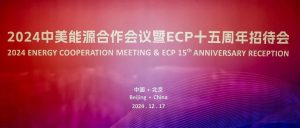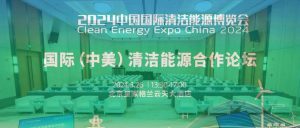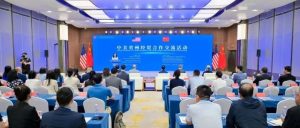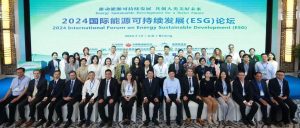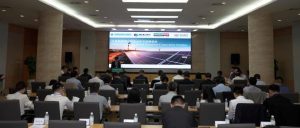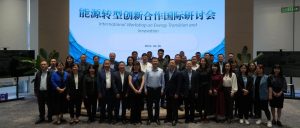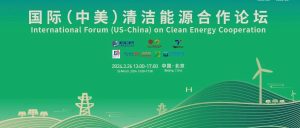为了更好地解读储能安全解决方案中的理念和政策,完善国内储能安全标准框架,分享交流国际储能安全经验和最佳实践,在应急管理部国家安全科学与工程研究院的参与支持下,中美能源合作项目(ECP)与北京朗泰华科技发展中心,上海化工研究院等合作伙伴于2021年12月21日在线上举办了“双碳”安全系列培训活动的第一期“电化学储能的安全标准建设”培训研讨会。来自伊顿电气、UL、豪士科、康菲、TUV 莱茵、科思创、液化空气及山东省商务厅、云南省消防救援总队、广州市场监管局、昆山发改委、应急管理部信息研究院、中国石油、国家能源集团、中国建筑、北京首都机场、南孚电池、腾晖光伏、罗姆半导体、远景能源等单位的 252 人报名参加了本次培训。
ECP与相关会员企业及合作伙伴于2021年启动“能源安全生产和应急安全标准国际合作计划”,此次储能安全标准培训研讨会是该系列合作的第一期,在当下双碳背景下,储能是能源绿色低碳转型过程中的关键技术之一和重要一环,在保证能源安全、推动能源绿色转型中发挥着重要作用,对双碳工作的稳步落实起到关键作用。此次研讨会邀请到了多位国内外知名机构和企业的标准和技术专家,从电化学储能标准入手,从行业政策、标准、技术、安全关键要点和难点、储能领域的标准建设工作和安全风险、技术更新、行业近况做了深度分享与解析。
(一)《电化学储能电站安全管理暂行办法》的编制过程及思考
中国电力企业联合会标准化管理中心的周丽波分享了《电化学储能电站安全管理暂行办法》的编制过程及思考。她介绍说,电化学储能建设周期短、布置灵活、响应速度快、用途广泛,是 落实“双碳”目标的重要支撑;储能产业安全发展要有标准体系来规范。电化学储能标准体系包括基础通用、规划设计、施工验收、安全环保等 9 个专业技术领域,规划标准共 150 项,已发布标准 89 项。为制定《电化学储能电站安全管理暂行办法》,团队相继开展了储能电站安全管理工作情况征集、国内外电化学储能电站安全事故分析、国内项目安全管理督导、项目调研等基础工作,积极听取相关单位的意见和建议;整体坚持“安全为本利于发展” 的理念,并根据现实中的典型问题提出针对性要求。下一步将加强重点标准编制,涉及储能电站安全、梯次利用、储能并网测试;深入开展基础问题研究并积极参加国际标准化工作。
(二)储能在加州气候政策中的作用
挑战和机遇美国加州能源委员会前主席 Bob Weisenmiller 的讲授内容为《储能在加州气候政策中的作用:挑战和机遇》,介绍了美国加州在储能应用和发展层面的实践与问题。气候变化对加州的影响凸显,大规模火灾愈加频繁。为控制温室气体排放,加州出台法案,要求2045年底前,100%的电力供应要来自可再生能源和零碳排放能源。为达成该目标,加州的太阳能和风能发电要达到目前的3倍,电池储能建设速率再提高7倍。目前,加州投资了多种储能科技,包含短时、长时和季节性储能,锂电池,液流电池,飞轮储能,热储能,高级抽水蓄能,绿氢等。目前的挑战在于,日落后太阳能发电下降,其他清洁电发电资源必须跟上,同时要解决电池安全问题,韩国、美国亚利桑那州和通用汽车的储能火灾给人们敲响了警钟。
(三)标准对消防安全和储能系统的影响
UL 标准工程项目经理Denice Durrant 的授课题目为《标准对消防安全和储能系统的影响》,重点介绍了UL 在消防领域的 标准矩阵和储能系统标准。UL 制定了300多项消防标准,涉及启动和指示装置、灭火 系统、耐火产品和建筑。在储能领域,有 UL9540《储能系统机设备标准》、UL9540A《电池储能系统热失控火蔓延评估的测试 方法》。两项标准均已成为美国和加拿大的国家安全标准。UL9540 是一个系统性标准,涵盖电化学储能、化学储能、机械 储能和热储能。UL9540A规定了 3 个测试级别:电池层面、模 块层面、单位层面和设备层面。除此之外,Denice 还介绍了 UL 的其他研究,如老化锂离子电池和模块的安全趋势、锂电池系统的热失控蔓延、锂离子电池火灾灭火剂和消费者电池安全。
(四)储能系统设计与运行控制
伊顿电气亚太区电力工程系统和服务、电源传输和服务部门专家佘慎思的授课题目为《储能系统设计与运行控制》,分享了伊顿公司在储能系统设计与运行控制方面的具体实践。储能在节约成本与产生收益方面具有很高价值,还可控制提高电网弹性。伊顿对储能的应用包含系统集成、无缝孤岛、黑启动、频率和电压控制、系统平衡、可再生能源优化集成及降低碳排放。伊顿还有对应的数字孪生平台及其系统建模与分析软件,专家通过介绍可再生能源平滑案例、削峰填谷案例解释了储能工作。在微电网控制方面,伊顿有 Power Xpert Energy Optimizer 控制系统、SMP 网关解决方案。最后总结了伊顿储能控制系统的控制器技术特点、微网应用技术特点、设计特点、应用场景及应用经验。
(五)电化学储能系统防火防爆设计和认证要点
上海化工研究院工业安全首席专家肖秋平的授课题目为《电化学储能系统防火防爆设计和认证要点》。他围绕“电化学储能系统防火防爆设计和认证要点”,从技术层面给大家讲解了电化学储能系统的概念与内容、标准与认证、储能系统安全性研究,UL储能系统认证以及储能系统的安全设计。肖秋平首先解释了电化学储能系统的概念及其危害,并对能 量无序释放导致的起火、爆炸和过热进行了分析,介绍了导致电化学储能系统发生能量失控的一些行为。再根据国内外储能电站事故案例,归纳出电化学储能站的防护策略,包括预防和保护两个方面。在标准与认证方面,他还将美国、欧盟、中国的储能系统标准进行了对比,他说,美国对技术标准的研究比较多,中国 则在政策制定方面开展的工作较多。最后重点分享上海化工研究 院按照UL 标准进行的电池检测及相关发现,以及检测结果对认证的启示。通过电芯层级测试、模块层级测试、机柜层级测试和 安装层级测试,他们提炼了储能系统安全设计流程图,可用来评估热失控火灾传播,分析热失控释放气体的常见组分;最后介绍了储能系统泄爆设计流程图、通风和惰化设计、抑爆设计等。
(六)储能系统电池安全技术
东南大学自动化学院产业教授童国道的授课题目为《储能系统电池安全技术》。他整体梳理了储能系统电池的安全形势、储能电池应用、电池性能与失效原因分析、相关技术标准、智慧电池与安全管理平台等。他的讲授从蓄电池事故案例及储能电站安全问题入手,强调要重视对储能电池安全问题,接着分析了储能电池的性能与失效原因,包括电池组链条特性、铅酸电池失效机理、锂离子电池热失控以及锂枝晶的形成原因。在技术标准方面,童教授介绍了电化学储能电站用锂离子电池管理系统技术规范、化工行业设计安 全检查标准以及企事业单位铅酸蓄电池运行安全技术规范等,最后分享了智慧电池与管理平台、电池安全运维管理平台及其应用经验,总结了蓄电池安全管理的要点及方向。
此次培训研讨会得到了参与各单位的积极反馈,大家积极提出了新的合作领域与兴趣点。根据反馈,在2022年,ECP将继续与各方合作伙伴,初步计划在氢能、防火、城市领域继续分享探讨能源行业的最佳安全实践和技术解决方案。如果想深度参与跟进此合作计划,请联系ECP团队,ecpgroup@amchamchina.org.
Carbon Peaking and Carbon Neutrality Safety Training Series
TheFirst Storage Safety Standardization Exchange Conference was successfully held in Beijing
In order to better interpret the concepts and policies in the energy storage safety solution, to improve the safety standard framework for energy storage in China and learn the international experience and best practice on the energy storage safety, with the participation and support of the National Academy of Safety Science and Engineering, MEM, the U.S.-China Energy Cooperation Program (ECP) and Beijing Safever Science & Technology Innovation Center, Shanghai Research Institute of Chemical Industry Co., Ltd.and related partners held the first session of Electrochemical Energy Storage Safety Standard Training Workshop online on December 21, 2021. 252 people from Eaton, UL, OSHKOSH, ConocoPhillips, TUV Rhineland, Covestro, Air Liquide and Department of Commerce of Shandong Province, Yunnan Fire rescue Corps, Guangzhou Administration for Market Regulation, Kunshan Development and Reform Commission, IIEM, China National Petroleum Corporation, CHN Energy, China State Construction, Beijing Capital International Airport Co.,Ltd., NANFU, TALESUN,ROHM Semiconductor, Envision signed up for the training.
It is the first session in a series of workshops between ECP and its member companies and partners to launch the Proposal on Safe Production and Emergency Safety Standards in 2021. Under the current dual carbon goal, energy storage is one of the key technologies and an important link in the process of green and low-carbon energy transformation. It plays an important role in ensuring energy security and promoting green energy transformation and plays a key role in the steady implementation of dual carbon goal. The workshop invited several experts from well-known institutions and enterprises at home and abroad to share and analyze in depth the standards of electrochemical energy storage from the perspectives of industry policies, standards, technologies, key points and difficulties in safety, standard construction, and safety risks in the field of energy storage, technology updates, and recent developments in the industry.
ⅠBriefing on the Safety Management Measures for Electrochemical Energy Storage Power Station
Zhou Libo from Standardization Department of China Electricity Council (CEC) shared the compilation process and thinking of the Safety Management Measures for Electrochemical Energy Storage Power Station. She introduced that Electrochemical energy storage has short construction cycle, flexible layout, fast response speed and wide application, which is an important support for the realization of dual carbon goals. The safe development of energy storage industry should be regulated by standard system.The electrochemical energy storage standard system includes 9 professional technical fields, including general planning and design, construction acceptance, safety and environmental protection, etc. There are 150 planning standards in total, and 89 standards have been published. In order to formulate the Safety Management Measures for Electrochemical Energy Storage Power Station, the team has launched a collection of work on the safety management of energy storage power stations, safety accident analysis of electrochemical energy storage power stations at home and abroad, supervision of safety management of domestic projects and project research and other basic work, and actively listened to the opinions and suggestions of relevant agencies, overall adhered to the “safety for development” concept, and put forward targeted requirements according to the typical problems in reality. The next step will be to strengthen the compilation of key standards, involving the safety of energy storage power station, cascade utilization and energy storage grid connection test; to carry out in-depth research on basic issues and to take an active part in international standardization work.
Ⅱ The Role of Storage in California Climate Policies
Ex-Chair Robert B.Weisenmiller presented The Role of Storage in California Climate Policies: Challenges and Opportunities. He introduced the practices and problems in the application and development of energy storage in California. The impact of climate change on California is becoming more and more frequent. To curb greenhouse gas emissions, California has passed a law requiring 100% of its electricity supply to come from renewable and zero-carbon sources by 2045. To do so, California would need to triple the amount of solar and wind power it is generating and increase the rate of battery storage construction sevenfold. Currently, California invests in a variety of energy storage technologies,including short-term, long-term, and seasonal energy storage technologies, lithium-Ion, flow batteries, flywheel systems, thermal energy storage, advanced pumped hydro, and green hydrogen. The challenge now is that as solar power declines after sunset, other sources of clean electricity must work, while addressing battery safety issues. Energy-storage fires in South Korea, Arizona and GM were wake-up calls.
Ⅲ The Impact of Standardson Fire Safety & Energy Storage Systems
Denice Durrant, Standards Engineering Program Manager, gave a speech entitled “The Impact of Standards on Fire Safety & Energy Storage Systems”, highlighting the UL Standards Fire Safety Matrix and energy storage system standards. UL has more than 300 fire safety standards covering initiation & indicating devices, fire suppression and fire resistance & construction. In the field of energy storage, there are UL9540 Standard for Energy Storage Systems and Equipment and UL9540A Test Method for Evaluating Thermal Runaway Fire Propagation in Battery Energy Storage Systems. Both standards have become national safety standards in the United States and Canada. UL9540 is a system standard covering electrochemical, chemical, mechanical, and thermal areas. The UL9540A provides four test levels: cell level, module level, unit level, and installation level. In addition, Denice presented other UL research on safety trends in aged li-ion cells and modules, thermal runaway propagation in lithium battery systems, fire suppressants for li-ion battery firesand consumer battery safety.
Ⅳ Energy storage system design and operation control
Shensi She, Expert of EESS(Electrical Engineering Systems & Services) and PDSS (Power Distribution Systems & Services) Division, Eaton APAC, gave a speech entitled”Energy Storage System Design and Operation Control”. He shared Eaton’s specific practice in energy storage system design and operational control. Energy storage is highly valuable in terms of cost savings and revenue generation, as well as controlling and improving grid resilience. Eaton’s applications for energy storage include system integration, seamless islands,black-start, frequency and voltage control, system balancing, renewable energy optimization integration and carbon emission reduction. Eaton also has the corresponding digital twin platform and its system modeling and analysis software. Experts explained the energy storage work by introducing there newable energy smoothing case and the peak cutting valley filling case. For micro-grid control, Eaton has Power Xpert Energy Optimizer control system and SMP Gateway solution. Finally, the controller technology characteristics, micro-grid application technology characteristics, design characteristics, application scenarios and application experience of Eaton energy storage control system are summarized.
Ⅴ Key Factors of EESS Fire Safety Design and Authorization
Qiuping Xiao, chief expert of Shanghai Research Institute of Chemical Industry Co., Ltd., gave a speech entitled “Key Factors of EESS Fire Safety Design and Authorization”. He explained the concept and content of electrochemical energy storage system(EESS), standards and certification, safety research of energy storage system, UL energy storage system certification and safety design of energy storage system from the technical level. Xiao Qiuping first explained the concept of EESS and its hazards, and analyzed the fire, explosion and overheating caused by the disorderly release of energy and introduced some behaviors leading to the uncontrolled energy storage system. According to the accident cases of energy storage stations at home and abroad, the protection strategies of EESS are summarized, including prevention and protection. In terms of standards and certification, he also compared the standards of energy storage systems in the United States, EU and China. ‘The U.S. has done more research on technical standards, while China has done more on policy making,’he said. In the end, he mainly shared the battery test conducted by Shanghai Research Institute of Chemical Industry Co., Ltd in accordance with ULstandards and related findings, as well as the enlightenment of the test results for certification. Through cell level test, module level test, unit level test and installation level test, they extracted the safety design flow chart of energy storage system, which can be used to evaluate thermal runaway fire transmission and analyze the common components of thermal runaway gas release. Finally, the flow chart, ventilation and inerting design and explosion suppression design of the energy storage system are introduced.
Ⅵ Safety Technology for Energy Storage Battery
Guodao Tong, Professor of Southeast University, gave a speech entitled “Safety Technology for Energy Storage Battery”. He summarized the safety of energy storage system battery,energy storage battery application, battery performance and failure cause analysis, related technical standards, smart battery and safety management platform. His speech began with battery accident cases and safety issues of energy storage power stations, emphasizing the importance of safety issues of energy storage batteries, and then analyzed the performance and failure causes of energy storage batteries, including the characteristics of battery pack chain, failure mechanism of lead-acid batteries, thermal runaway of lithium-ion batteries and the cause of lithium dendrite formation. In terms of technical standards, Professor Tong introduced electrochemical energy storage power station with lithium-ion battery management system specification, design of the chemical industry safety inspection standard and safe operation of enterprises and institutions lead-acid battery technical specification. Finally, he shared the wisdom and management platform, battery safety operations management platform and application experience, and summarized the battery and the direction of the main points of the safety management.
The seminar received positive feedback from all the participating companies and organizations, and they put forward new areas of cooperation and points of interest. Based on the feedback, ECP will continue to share best safety practices and technical solutions with various partners in the sector of hydrogen, fire prevention and urban in 2022. Please contact the ECP team if you would like to be deeply involved in this collaboration ecpgroup@amchamchina.org .

